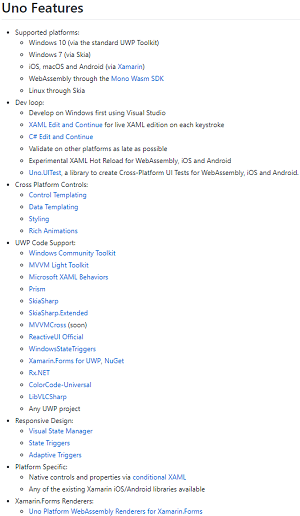News
Uno Platform 3.5 Instantly Supports WinUI 3 Preview 4 as Part of #WinUIEverywhere
Uno Platform, an innovative player in the .NET-centric development world, reaffirmed its support for #WinUIEverywhere in its new v3.5 release, announcing day-zero support of Microsoft's UI platform for Windows apps, WinUI 3 Preview 4.
That preview put Microsoft's WinUI on course for a production debut next month for the offering that uses Fluent Design to provide a native user experience (UX) for both Windows Desktop (Win32) and Universal Windows Platform (UWP) applications.
"It provides a way to gradually migrate existing apps written in familiar technologies like MFC, WinForms and WPF, allowing you to move these applications forward at your own pace," the WinUI site states. "It also supports familiar languages spanning C++, C#, Visual Basic and even Javascript via React Native for Windows."
 [Click on image for larger view.] Uno Platform Features (source: Uno Platform).
[Click on image for larger view.] Uno Platform Features (source: Uno Platform).
The instant support for WinUI 3 Preview 4 led a host of new and enhanced features in Uno Platform 3.5, which follows up on the August 2020 v3.0 release that introduced preview support for Linux.
Uno Platform says its open source and professionally supported flagship offering helps developers build native mobile, desktop and WebAssembly apps with C#, XAML with just a single codebase.
Uno Platform has increasingly touted its innovations in the ecosystem surrounding .NET and Microsoft development, making advances in WebAssembly (used to power Microsoft's red-hot Blazor project for C#-based web development) and other areas. For example, just over a year ago Uno Platform claimed a first and addressed a "long-time request" by announcing the capability to build WebAssembly apps in Visual Studio on Windows using Ahead of Time (AOT) compilation. AOT is a much-wanted, long-awaited capability for speeding up Blazor and other .NET 6 projects.
The company also ported the Windows Calculator to Linux and announced new a new capability that lets developers take existing Xamarin.Forms mobile apps to the web via WebAssembly.
Uno Platform 3.5 introduces four new controls, closes more than 100 issues and reaffirms its commitment to WinUI 3 as exemplified with the hashtag #WinUIEverywhere used on Twitter.
Along with support for WinUI 3 Preview 4, the new release also supports the new Xamarin.Forms 5 and introduced official support for SkiaSharp, a cross-platform 2D graphics API for .NET platforms that's based on Google's Skia Graphics Library, especially pertinent for WebAssembly. Previously, a SkiaSharp fork was used.
The four new controls introduced are: Navigation View, Progress Ring, Pager and Expander.
All of those and every single other thing that's new in Uno Platform 3.5 can be explored on the GitHub releases page.
Going forward, Uno Platform plans zero-day support for the production-ready, general availability release of WinUI 3, which is expected next month. Also on the list of 2021 efforts is "tripling down on Web/WebAssembly," along with more control mappings, tooling experiments and the endorsement of .NET 6 in November. That effort will be Microsoft's milestone, long-term support (LTS) release that unifies everything .NET under one umbrella framework.
".NET 6 is expected to RTM in the second part of 2021," Uno Platform said in its 2021 roadmap that was published in late December (November is Microsoft's target date). "We expect to be able to leverage a lot of goodies that will come with it, just like we did with .NET 5. What exactly will be decided as .NET 6 deliverables become available. But rest assured that we will inherit any productivity or performance accelerators coming with .NET 6."
About the Author
David Ramel is an editor and writer at Converge 360.